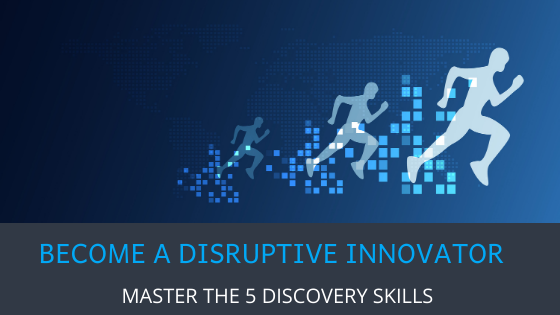History is evident that disruptive innovators have the ability to change the world for better; be it Jeff Bezos, Steve Jobs, Elon Musk…
In his farewell letter to his employees, Jeff Bezos talked about innovation being the root of Amazon’s success. “We’ve done crazy things together, he said, and then made them normal.” Steve Jobs is always remembered for his words about innovators and trailblazers about whom he says “…while some may see them as the crazy ones, we see genius, because the people who are crazy enough to think that they can change the world, are the ones who do.”
Most people say – ‘Disruptive Innovators’ are wired differently. However, I feel what we are calling as wired differently is just a capability to see things from multiple perspectives.
Clayton has called these perspectives “Discovery Skills”, in the book “The Innovator’s DNA”. Clayton claims if you can acquire these skills, you can also think like disruptive innovators. This implies if we can teach them to our teams, we can make our organization more innovative. Let’s see what are these ‘Discovery Skills’ and how we can teach them to our people:
- Associating
- Questioning
- Observing
- Networking
- Experimenting
Disruptive Innovators | Discovery Skill #1 Associating
Being at the cusp of different disciplines and finding ways to associate them to create ideas that are out of the box is the first discovery skill. How do you train your mind to do this?
Tip #1 – Force New Associations
Combine things that you wouldn’t usually put together. Look around your home and life and find the two most used gadgets but unlikely to be used as a single one and force your mind to make the best possible association. We are picking a refrigerator and Google Home.
| Refrigerator + Google Home |
Let’s of think some potential associations:
- How about talking to the refrigerator just the way we talk to Google Home and asking – “How many cartons of milk are left in the fridge?” instead of opening the fridge and checking ourselves.
- Or how about asking the fridge to ring a bell when your home made ice-cream is set and ready to dig into? Just the way we ask Google Home to set timers.
As a systematic approach, create a table as follows. Pick a problem(s) you are facing, identify a random item or idea. For inspiration, look around you. Now try to come up with an association of these two. Here are some examples for your reference:
| Unsolved problem | Unrelated random item or idea | Potential Association |
| How do I get more users to download my new mobile adventure treasure hunt gaming app? | Running shoes | Create a feature where the game uses the phone camera as a projector and allows the user to treat it as a VR experience. |
| How do I prepare my workforce for a post covid comeback? | House plant | Create a temperature controlled outdoor, socially distanced workspace where masks need not be worn. Create an atmosphere that feels safe and comfortable and makes your workforce want to be present. |
| ……Your turn……. | ……… | ……… |
Tip #2 – Take on a Different Persona
Take on a different persona. Even by physically altering the way you look and dress, you can force yourself to think like someone you are not. For example, if you’re looking for design innovations with a twist of utility, dress in a black t-shirt and blue jeans for a week so you can feel like Steve Jobs. Let his association of learning calligraphy to subsequently create fonts on his computers inspire you.
Tip #3 – Generate Metaphors and Analogies
Find ways to look at things from an uncommon perspective. Use metaphors and analogies to think of products that you could revolutionize. Ever thought of an AI powered smart ceiling lamp that can watch over patients? The device being smart enough to know if the patients are sitting, standing or laying down and to call out for help if they fall down.
| List of Products (“What if” Metaphor) | Possible New Features/Benefits |
| “What if” we aren’t controlling video game characters using a remote, but with our brains? What if they just so happen to be going exactly where we want, when we wanted? | Mind control gaming with increased efficiency and lesser need of hand eye coordination Device-less, play from anywhere, unrestricted game time |
| “What if” | |
| ………Your turn…….. | ……… |
Tip #4 – Build Your Own Curiosity Box
Collect and put together things from your travels and explorations, things that may not be useful even. Put them together in a box to trigger your curiosity or even display them where they jump out at you everyday. When faced with a problem, look at them and allow them to let you come up with out-of-the-box solutions.
Tip #5 – Use SCAMPER to Generate Breakthrough Ideas
SCAMPER! Substitute. Combine. Adapt. Magnify, Minimize, Modify. Put to other uses. Eliminate. Reverse, Rearrange. An acronym to inspire innovation and generate insight, use the concepts that this acronym stands for to rethink and allow you a fresh perspective to a problem you may be facing.
| SCAMPER Challenge | Invent a new type of Vending Machine |
| Substitute | Substitute salespersons at stores with vending machines – unmanned and cashless stores |
| Combine | Sell advertisement space by installing a screen |
| Adapt | Install QR codes/screens for digital payments |
| Magnify, minimize, modify | Modify receiving tray to be soft and padded to minimize breakage of delicate items |
| Put to other use | Turn traditional vending machine into fresh juicer by replacing packaged food and drink with fresh fruit and juicing mechanism |
| Eliminate | Eliminate the keypad to punch in codes for products. Maybe use a touchscreen for product selection. |
| Reverse, rearrange | Instead of taking stuff out of a vending machine, humans get inside and use it as plug and play office |
You might also like to read this post on “Innovations in Aerogels With SCAMPER”.
Disruptive Innovators | Discovery Skill #2 Questioning
Questioning is the art of learning. Questions seek and frame and expose. Answers change over time, with varying degrees of accuracy and subjectivity. But ask the right questions and you will be amazed how the doors to innovation open.
Tip #6 – Engage in QuestionStorming
When brainstorming finds you caught in a rut, try QuestionStorming. When you sit down together as a team, ask What if, What caused, Why, Why not, What is questions. Write down every question and once listed, prioritize and discuss the most important or intriguing ones to find better solutions.
Tip #7 – Cultivate Question Thinking
When discussing products and/or innovations within your company, convert your statements into questions. By reformulating statements into questions, you will find not only do the problems you are facing become clearer and help members of your team feel responsible for solutions. Teach your team members in the orientation session about the first principle of thinking.
You would love reading this one too – “7 ways to Encourage Innovative Thinking at Your Workplace”.
Tip #8 – Track your QnA Ratio
Keep tabs on your Q&A ratio. Studies have shown that disruptive innovators ask more questions than give answers. And more often than not, good questions generate greater value than good answers.
Tip #9 – Cultivate your own Question Bank
Maintain a record of your questions as your own written question bank. Keep revisiting these questions to identify patterns and categorize the kinds of questions you are asking. When you do, question your own questions to disrupt your thought to lead to better innovation.
The table below will help you ask the right questions.
| Describe the Territory | Disrupt the Territory | |||
| Innovator’s DNA Skills | What is? Who? What? When? Where? How? | What caused it? | Why? Why not? | What if? How might? |
| Observing | ||||
| Networking | ||||
| Experimenting |
Ask more questions when you go through your question bank. Question your questioning patterns, try and understand which questions generate emotional responses, see what kind of questions lead you best into disruptive thinking patterns.
Disruptive Innovators | Discovery Skill #3 Observing
Whether it was Einstein with his theory of Gravity or Galileo measuring time with a pendulum; all innovators, thinkers and makers had something in common. They noticed, they observed and they theorized. Observation is the bedrock of innovation. It is where innovation starts.
Tip #10 – Observe Customers
Observe the people you are making your product for, the existing customers. Observe how these customers experience your product. Look out for what they enjoy most about your product, and look out for what is leaving them dissatisfied about it. Is there a functional connect only or is your product leaving your customer emotionally connected?
Tip #11 – Observe Companies
Identify a company you like, or one that inspires you. It may be a blue chip company or a trailblazing start-up. Dig into its hows and whys and think of ways you could incorporate its ideas into your business or product.
Tip #12 – Make Observation a Habit
Set time aside everyday to observe. Make it a task in your daily to do list. Set aside a few minutes each day to observe the world around you, or a part of it that catches your fancy. Note down (this may even be photographs and videos on your phone) your observations and review them every once in a while.
Tip #13 – Observe With All your Senses
Observe with more than just your mind. Whether you are observing customers, another company or the world around you, observe with all your senses. Make it a habit to see, taste, hear, smell and feel every experience. Make notes about what responses various experiences trigger in you. You never know what explosive idea is hiding under a whiff of something!
Disruptive Innovators | Discovery Skill #4 Networking
Idea networking is about you stepping out of your comfort zone and engaging with people who have thoughts that may be different from your own. Fresh thoughts, ideas and perspectives are a powerful arsenal to carry in your toolkit.
Tip #14 – Expand your Network Diversity
If you are the smartest person in a room, you are in the wrong room. So, like Tony Robbins says, surround yourself with people who are successful, who are forward-moving, who are positive, who are focused on producing results, who support you, it will challenge you to be more and do more and share more. If you can surround yourself with people who will never let you settle for less than you can be, you have the greatest gift that anyone can hope for. Expand the diversity of your network. Engage with people of different ages, socio-economic backgrounds, gender, profession, industry, countries.
Tip #15 – Start a Mealtime Networking Plan
Don’t have the time to expand your network? Start doing so over a meal. Have a meal with someone in your organization or social circle you never would ordinarily. Step outside your comfort zone if you have to to engage with a person you may not always agree with.
Tip #16 – Plan and Attend New Events Each Year
Attend conferences and seminars as an opportunity to network and learn alongside. Choose a couple of conferences/seminars to attend in a year – one in a subject that interests you and another that is outside your comfort zone. This is a great way to meet people with different perspectives.
Tip #17 – Foster a Creative Community
Become part of, or better still, initiate a creative community and meet regularly to nurture ideas beyond your workplace. Invite outsiders to these meetings to get fresh ideas. Let the people you invite be a healthy mix of experts and novices so you can draw on both experience and raw enthusiasm. Train with the experts and let the exuberance of newness ignite your passion.
Disruptive Innovators | Discovery Skill #5 Experimenting
Experimentation is fundamental to get insights and new knowledge and in relation to innovation, experimentation is usually seen as a “search for new value”, a journey to innovation.
Tip #18 – Cross Physical and Intellectual Borders
Changing spaces – both physical and intellectual help you break out of routine and fixed mindset. Visit new places – museums, libraries, parks. Join new professional or recreational activities, attend lectures, take an online class or indulge in art. Subscribe to content from different contexts and different geographies. When you open yourself up to alien information, you will see yourself shift from a routine mindset to a hypothesis-testing mindset.
Tip #19 – Invest Time in Developing a New Skill
Find something you are passionate about beyond your work. Turn it into a skill that you work to develop. It could be painting or photography or ballet or yoga. If you don’t want to go that far, identify another function in your company and explore it deeply.
Tip #20 – Disassemble a Product and Build a Prototype of an Idea
Have something old at home that is gathering dust? Turn it into a weekend repair project. Take it apart, study it and try to reassemble it. Have something at home that you think you could make better? Engage in a product improvement project and turn it into a prototype! Play-doh and Lego are great to create prototypes with your kids and to initiate them into innovation early.
Tip #21 – Be Regular with Piloting New Ideas
Pick up ideas from the idea books you are maintaining and make a commitment to yourself to carry out a pilot test of one of those every month. If it doesn’t work the first time, experiment on it the next time with a small tweak here and there.
Tip #22 – Go Trend Spotting
Stay up to date with the happenings around you and constantly be on the lookout for emerging trends. Look into the future with the resources you have today and try and think of how you can ride the trend wave.
Let’s Sum It Up
In sum, remember to keep moving. Remember you don’t have to be born an innovator. You can join the league of disruptive innovators. And while you’re on the innovation treadmill, let Bezos’ words ring loud – “Keep inventing and don’t despair when at first the idea looks crazy. Remember to wander. Let curiosity be your compass. It remains Day 1.”
Read Next: “How To Seek Investment Using Patents?“
Want to get more invention disclosures at your enterprise?
Download this inventor friendly ‘Invention Disclosure Form‘ by TIP today!
Note: The preceding is general business advice and not to be construed as legal advice. IP laws vary by country and retaining licensed legal counsel is advised to confirm this information. Any expressed or implied opinions are of the author and do not necessarily reflect the views of Triangle IP or any other entity who might be associated with the presenter. We hope this content is helpful to you, but should not be relied upon without confirming the advice and accuracy with local legal counsel. Any comments or inquiries are not confidential so please discuss your issues directly with counsel.



